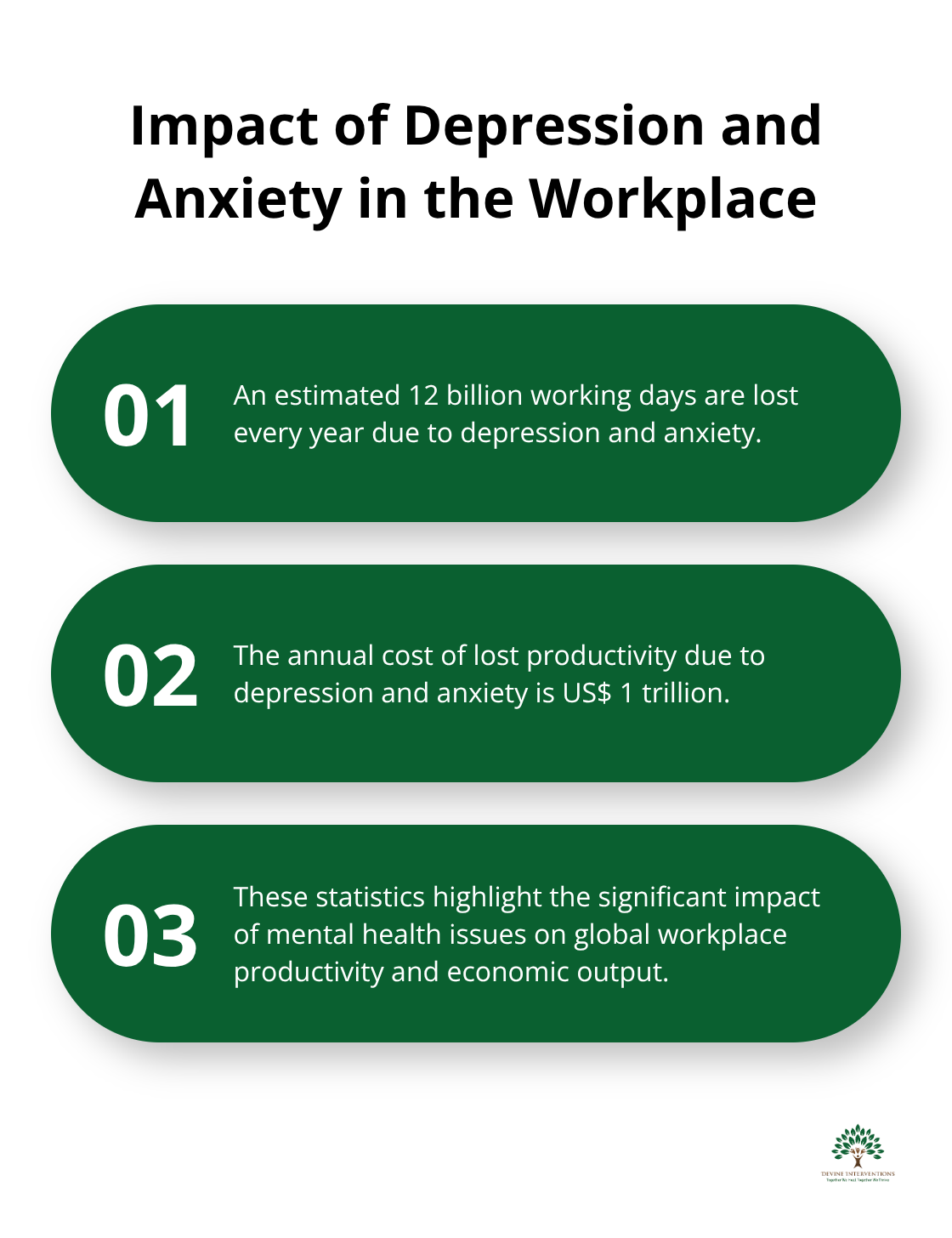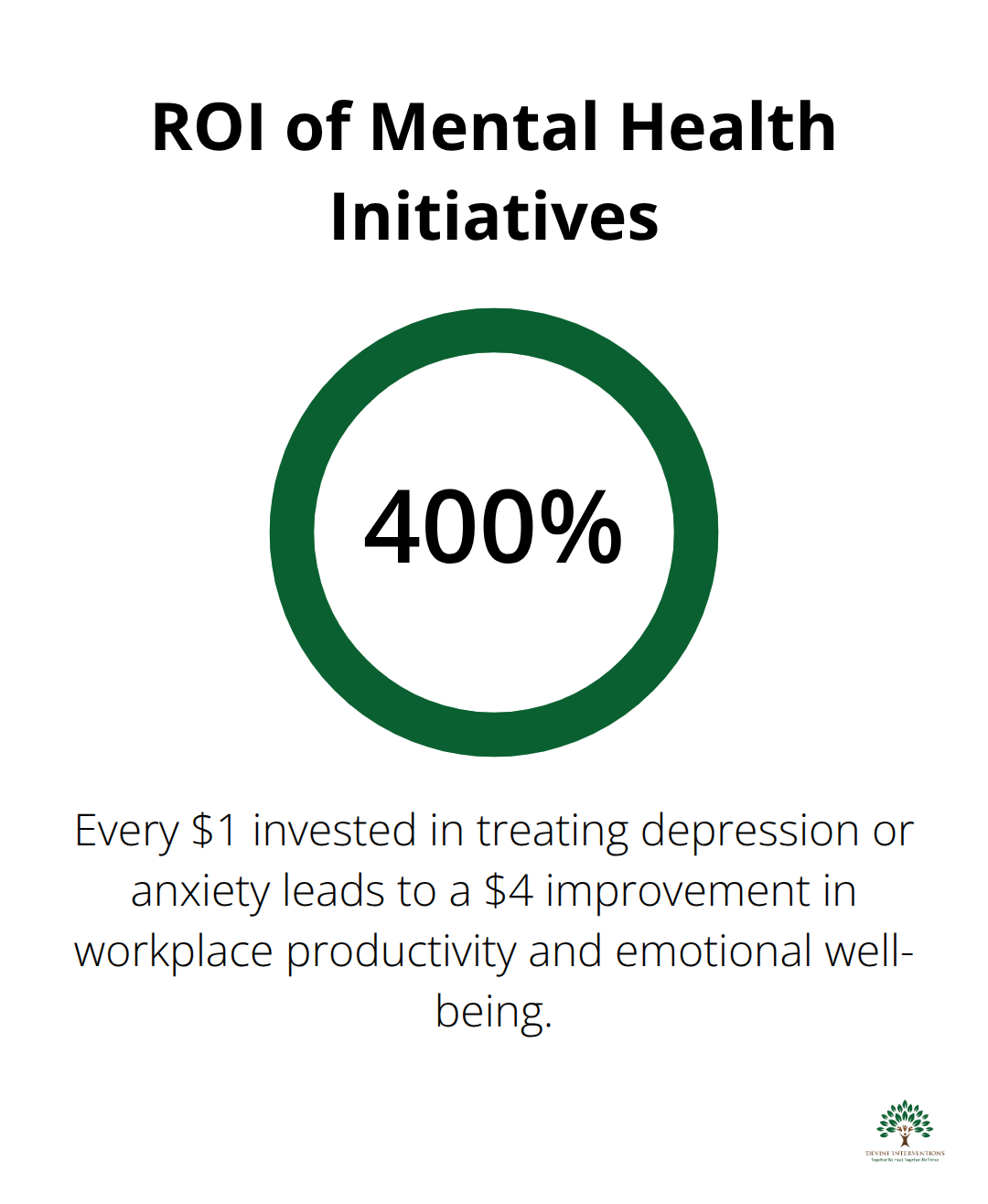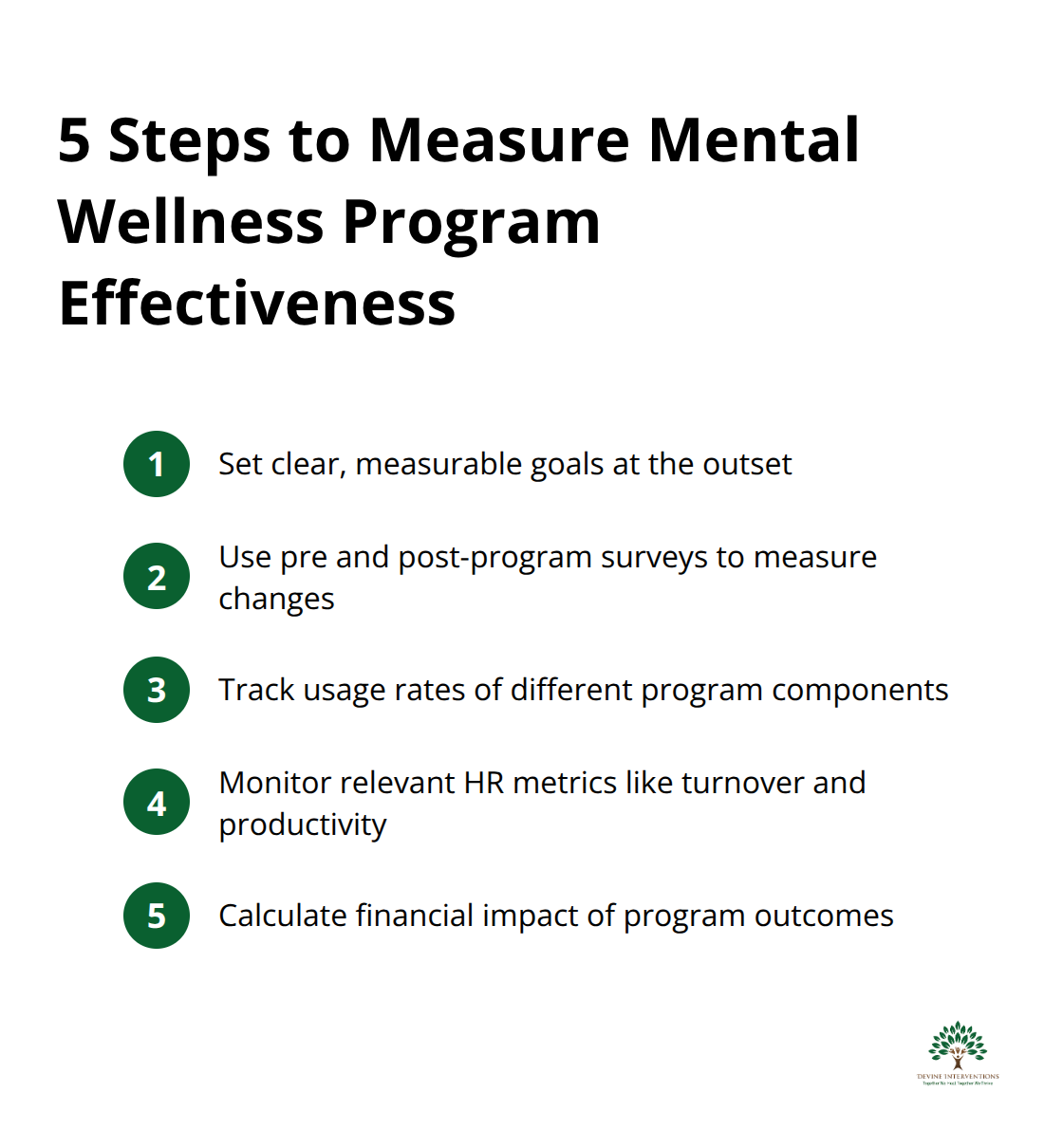At Devine Interventions, we’ve seen firsthand the positive impact of corporate mental wellness programs on both employees and businesses.
These initiatives are no longer optional extras but essential components of a thriving workplace. They boost productivity, reduce absenteeism, and foster a positive company culture.
This guide will walk you through the key steps to implement an effective mental health program in your organization.
What Are Corporate Mental Wellness Programs?
Defining Mental Wellness in the Workplace
Corporate mental wellness programs are strategic initiatives that support and improve employee mental health. These programs transform workplaces, boost individual well-being, and enhance overall company performance.
Mental wellness at work isn’t just a trendy concept – it’s a critical factor in employee satisfaction and productivity. Globally, an estimated 12 billion working days are lost every year to depression and anxiety at a cost of US$ 1 trillion per year in lost productivity. Effective mental wellness programs can significantly reduce these costs while creating a more positive work environment.

Benefits Beyond the Bottom Line
The advantages of corporate mental wellness programs extend far beyond financial gains. Employees who participate in these programs report:
- Lower stress levels
- Improved job satisfaction
- Better work-life balance
For employers, this translates into:
- Reduced absenteeism
- Increased productivity
- Higher retention rates
Key Components of Successful Programs
Effective corporate mental wellness programs typically include a mix of services and resources. These often encompass:
- Employee Assistance Programs (EAPs): Confidential counseling services for personal and work-related issues.
- Mental Health Education: Workshops and training sessions on stress management, mindfulness, and resilience.
- Flexible Work Arrangements: Options for remote work or flexible hours to promote work-life balance.
- Wellness Challenges: Team-based activities that encourage healthy habits and foster social connections.
- Digital Mental Health Tools: Access to apps and online resources for self-guided mental health support.
The most successful programs are those that companies tailor to the unique needs of each organization. They’re not one-size-fits-all solutions, but rather carefully crafted initiatives that reflect the company’s culture and address specific employee concerns.
The Power of Investment in Mental Health
Companies that invest in corporate mental wellness programs send a powerful message: they value their employees’ mental health. This approach not only improves individual lives but also creates a more productive, engaged, and loyal workforce. It’s a win-win situation that smart businesses increasingly recognize and act upon.
As we move forward, it’s important to understand how to implement these programs effectively. The next section will outline key steps to create a successful mental wellness program in your organization.
How to Build an Effective Mental Wellness Program
Conduct a Thorough Assessment
Start your journey to a successful corporate mental wellness program with a comprehensive evaluation of your workplace culture and employee needs. Use anonymous surveys, focus groups, and one-on-one interviews to collect honest feedback. Ask about stress levels, work-life balance, and specific mental health concerns. This data will help you tailor your program to address the most pressing issues.
A tech company (not affiliated with Devine Interventions) discovered that 70% of their employees experienced high stress due to long working hours. This insight led them to prioritize stress management and work-life balance initiatives in their program.
Obtain Leadership Support
Your mental wellness program needs strong backing from the top. Present your assessment findings to leadership, highlighting the potential return on investment of mental health initiatives. The World Health Organization reports that every $1 invested in treating depression or anxiety led to a $4 improvement in workplace productivity and emotional well-being.

Encourage leaders to participate in the program visibly. When executives openly discuss mental health and use program resources, it normalizes seeking help and reduces stigma.
Create a Comprehensive Strategy
Develop a detailed action plan based on your assessment and leadership input. Include specific goals, timelines, and responsible parties. Your strategy should encompass various elements such as:
- Education and awareness campaigns
- Access to mental health professionals
- Stress reduction techniques
- Work-life balance policies
- Manager training on mental health support
Set measurable objectives. Try to increase employee engagement scores by 15% or reduce absenteeism by 20% within the first year of implementation.
Select Appropriate Resources
Choose mental health resources that align with your employees’ needs and preferences. This might include:
- On-site counseling services
- Teletherapy options
- Mindfulness practices
- Stress management workshops
- Fitness classes
Develop an Engaging Communication Plan
Create a robust communication strategy to promote your mental wellness program. Use multiple channels such as email, intranet, posters, and team meetings to reach all employees. Share success stories and testimonials to inspire participation.
A company (unrelated to Devine Interventions) saw a 50% increase in program engagement after implementing a peer ambassador program, where employees shared their personal experiences with mental health resources.
Implementing a corporate mental wellness program requires ongoing effort and adjustment. The next chapter will explore common challenges you might face during implementation and strategies to overcome them.
Tackling Implementation Hurdles
Breaking Down Mental Health Stigma
Mental health stigma remains a significant barrier in many workplaces. To combat this:
- Encourage leadership to lead by example. A CEO who shares their experience with therapy can normalize mental health conversations.
- Use clear, non-stigmatizing language. Replace “mental illness” with “mental health challenges” or “mental wellbeing.”
- Make mental health discussions part of regular team meetings. This normalizes the topic in workplace dialogue.
- Highlight success stories (with permission). Showcase employees who’ve benefited from your mental wellness program.
Building Trust and Confidentiality
Employees need to trust that their mental health information will remain confidential. Here’s how to build that trust:
- Communicate your confidentiality policies clearly. Explain exactly how you protect information and who has access to it.
- Use external providers for counseling services. This adds an extra layer of privacy.
- Train managers on confidentiality. They should know how to support employees without breaching privacy.
- Offer anonymous options. Some employees might prefer using mental health apps or online resources initially.
Measuring Program Effectiveness
Demonstrating ROI is important for long-term program success. Here’s how to effectively measure your program:

Adapting to Diverse Needs
One-size-fits-all approaches often fall short. Here’s how to cater to diverse employee needs:
- Offer a variety of resources. Some employees might prefer in-person counseling, while others opt for digital tools.
- Consider cultural differences. Ensure your program is inclusive and culturally sensitive.
- Address different life stages. Young professionals might need different support than those nearing retirement.
- Provide options for various work schedules. 24/7 helplines or on-demand video counseling can support shift workers.
- Seek feedback and adjust regularly. Use focus groups or surveys to understand changing employee needs.
Implementing a mental wellness program is an ongoing process. It requires continuous evaluation and adaptation. Organizations can transform their workplace culture by persistently addressing these challenges. With the right approach, your mental wellness program can significantly impact employee wellbeing and organizational success.
(If you’re looking for expert guidance in implementing a corporate mental wellness program, consider reaching out to Devine Interventions. Our team can provide tailored solutions to address your organization’s unique needs.)
Final Thoughts
Corporate mental wellness programs transform workplaces, boost productivity, and foster positive company cultures. These initiatives reduce absenteeism and create supportive environments that benefit employees and the bottom line. Organizations that prioritize mental health attract top talent, foster innovation, and maintain a competitive edge in today’s dynamic work landscape.
We at Devine Interventions have witnessed the powerful impact of well-implemented mental wellness programs. These programs improve job satisfaction, work-life balance, and retention rates, with positive effects rippling throughout entire organizations. Companies that invest in mental wellness demonstrate their commitment to employee well-being, shaping healthier and more resilient workforces.
The journey to prioritize employee mental health may seem challenging, but the rewards are immeasurable. We encourage all businesses to take the first step towards implementing corporate mental wellness programs. (Our team at Devine Interventions can provide expert guidance and tailored solutions to address your organization’s unique needs.)







